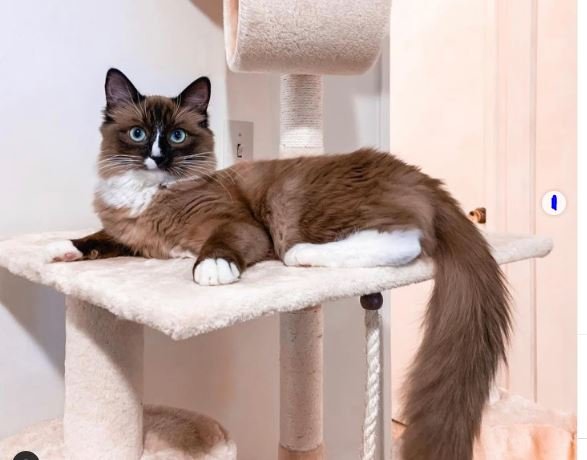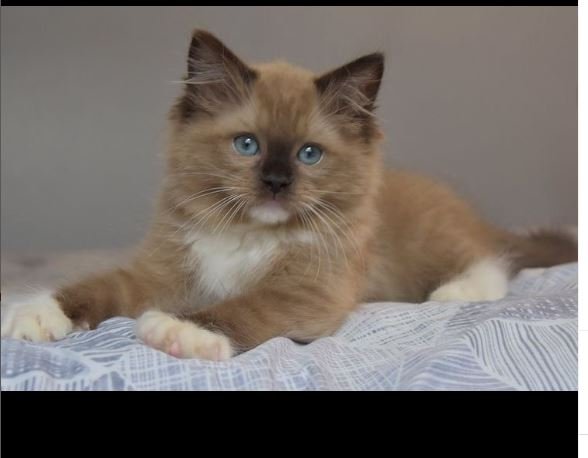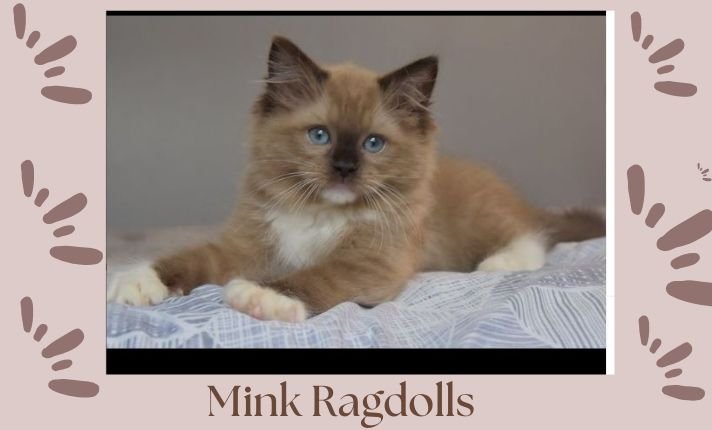Mink Ragdoll cats are a delight to behold with their stunning appearance and endearing personalities. As a variant of the beloved ragdoll breed, Ragdolls boast a unique coat pattern and soft, silky fur that is irresistible to touch.
These cats are known for their affectionate nature, often seeking human interaction and cuddles, making them perfect companions for families and cat lovers alike. Mink Ragdoll brings joy and warmth to any home, becoming a lovely member of the family.
In this article, you will find everything you need to know about Mink Ragdoll cats, from their origins and genetics to their daily care and personality.
History of Mink Ragdoll Cat :
Mink Ragdoll cats originated from Ann Baker’s Ragdoll breeding program in Riverside, California, in the 1960s. They emerged as a variation within the Ragdoll breed due to selective breeding, which emphasized their unique coat texture and richer color variations. The Mink Ragdoll’s genetic makeup is a result of combining the pointed gene(cs) and the Burmese gene(cb), creating the CBCS gene.
This genetic combination sets them apart from traditional Ragdolls. Mink Ragdolls are recognized by the International Cat Association(TICA) as purebred Ragdolls.
Mink Ragdoll Breed Overview
| Breed | Detail |
| Coat | Soft, silky with a mink-like texture |
| Eye color | Aqua (blue-green) |
| Height | 23-28 cm |
| Weight | 12-20 pounds |
| Life Span | 12-16 years |
| Personality | Affectionate, gentle |
| Living style | Indoor cats |
| Suitable for | Great for families |

Mink Ragdoll Kitten Development Stages
Here’s an overview of the development stages of a mink Ragdoll cat:
Kittenhood ( 0-12 months): Newborn kittens are blind and helpless, relying on their mother for warmth and nutrition. Gradually, after 4-8 weeks, they start to open their eyes and begin to crawl. After that, they explore their surroundings, play, and develop social skills.
Adolescence (1-2 Years): kittens continue to grow and develop physically, reaching about 75% of their adult size by 6 months. They learn social skills such as interacting with humans and other animals. They can start learning basic training, such as litter box use and simple commands.
Maturity ( 5+Years): At this age, mink Ragdolls reach their full maturity both physically and mentally. With proper care, Mink Ragdoll can live up to 12-17 years or more, providing long-term companionship.
Food and Nutrition of Mink Ragdoll Cat
Mink ragdolls require a balanced diet that meets their nutritional needs. Here are some guidelines:
1. High-quality protein: Mink Ragdolls are obligate carnivores and require a diet rich in protein from animal sources.
2. Moderate Fat Content: They need a moderate amount of fat for energy and skin health.
3. High-quality commercial Cat Food: Look for premium cat food that meets their nutritional needs.
4. Wet Food: Wet food can help with hydration and provide variety in their diet.
5. Raw and Cooked Meat: Some owners choose to feed their mink Ragdolls raw or cooked meat, but it is essential to ensure it is safe and balanced.
How many meals per day?
Feed your Mink Ragdoll cat 2-3 meals a day by dividing their ration into 2-3 meals to maintain a healthy weight. Consult with your veterinarian to determine the best feeding schedule and protein size for your Mink Ragdoll. Monitor their weight and adjust their food intake accordingly to prevent obesity. Choose healthy treats for low-calorie, rich treats such as freeze-dried chicken or greenies dental chews. Treats should not make up more than 10% of their daily calorie intake. Ensure that mink Ragdoll cats always have access to fresh, clean water.
Types of Mink Ragdoll Cats
Mink Ragdoll cats come in various colors and patterns, including.
Seal Mink Ragdoll:
Seal Mink Ragdoll has a warm, medium-brown body with darker seal points and has aqua blue eyes that complement the seal points. They are known for their affectionate and playful nature.

Blue Mink Ragdoll:
They have a gray tone with slate-grey points and a silvery body. They are known for their calm and gentle nature.

Chocolate Mink Ragdoll:
They have milk-chocolate points with a creamy tan or ivory body and have aqua blue eyes that contrast with the warm coat color. They are known for their friendly and outgoing nature.

Lilac Mink Ragdoll:
They have pale frosty-grey bodies with lavender-gray points. Lilac Ragdolls are known for their playful and curious nature.

Cream Mink Ragdoll:
These cats have light beige points with a creamy white body, they have aqua blue eyes and a creamy coat, and are known for their gentle and affectionate behavior.

Flame Mink Ragdoll:
They have deep orange-red points with a light cream body and aqua blue eyes, and are known for their energetic and playful nature.
Grooming tips for Mink Ragdolls
Mink Ragdoll has a beautiful, soft coat that requires regular grooming. Here are some grooming tips.
Brushing: Brush your mink ragdoll 2-3 times a week to prevent matting and tangling. Use a slicker brush to gently remove tangles or mats and especially around sensitive areas like the face and ears.
Bathing: Bath Mink Ragdolls occasionally, as needed to keep their coat clean and healthy. Use a mild shampoo specifically designed for cats. Overbathing can strip their coat of its natural oils, leading to dryness and irritation.
Nail Care: trim your mink ragdoll’s nails regularly to prevent overgrowth and scratching damage. Use a nail clipper or grinder to trim their nails.
Ear and Eye care: Clean your mink eyes and ears regularly. Clean their ears with a soft cloth to prevent wax buildup and infection. Check their eyes for signs of discharge, redness, and irritation.
Common Health issues of Mink Ragdoll cats
Mink Ragdoll cats are prone to several health issues, including.
1. Heart conditions: It is a condition in which the heart muscle thickens and makes it harder for the heart to pump blood efficiently. Its symptoms include loss of appetite, lethargy, rapid breathing, and hind limb paralysis due to a blood clot.
2. Kidney Issues: It is a disorder that leads to the formation of cysts in the kidneys. Its symptoms are increased thirst, frequent urination, and weight loss.
3. Urinary problems: It is a bacterial infection that causes frequent urination, straining, and blood in the urine.
4. Metabolic issues: A condition where the body can not regulate blood sugar levels, leading to increased thirst, frequent urination, weight loss, and lethargy.
Other common health issues of Mink Ragdoll cats are dental problems, vision issues, joint issues, and respiratory issues.
Training and Socialization Tips
Mink Ragdolls are known for their intelligence, affectionate nature, and adaptability. Here are some training and socialization tips to help you raise a well-behaved and well-adjusted mink Ragdoll.
Positive Reinforcement: Reward good behavior with treats and praises. You can encourage your cat to repeat the desired behavior. This approach helps build trust and strengthens the bond between you and your cat.
Clicker Training: Clicker training is a precise method that uses a clicker to mark desired behavior immediately followed by a reward. This technique helps your mink associate the sound of the clicker with positive behavior.
Litter Box Training: Litter box training is essential for maintaining a clean and hygienic environment. By placing your Mink Ragdoll in the litter box after meals and naps, you can create a routine and help them learn to use the litter box correctly. Consistency and patience are key to successful litter box training.
Basic commands: teaching basic commands like sit, stay, and come can help you communicate effectively with your Mink Ragdoll. Use positive reinforcement techniques such as treats and praise to encourage your cat to follow commands.
Difference between Mink Ragdoll and other Ragdoll cats
| Characteristics | Mink Ragdoll | Other Ragdoll cat |
| Coat coloration | Darker and richer tone, warm brownish hue | Variety of coat colors, including solid, pointed, and bicolor |
| Coat Pattern | Mink-like texture and coloration, warm and luxurious | Variety of coat colors, including solid, pointed, and bi-color |
| Eye Color | Aqua -blue eyes | Pointed, mitted, bi-color, and other patterns |
| Coat Texture | Soft and silky, but may vary in texture | Blue, copper, gold, and other |
| Overall Appearance | Unique coat coloration and pattern, stunning appearance | Beautiful appearance, variety of coat colors and patterns |
Interesting facts about Mink Ragdoll cats
Here are some interesting facts about Mink Ragdoll Cats.
1. Unique coat coloration: Mink Ragdoll has a distinctive coat coloration with a warm, brownish hue and darker points.
2. They have Aqua Blue Eye Color: Mink ragdoll has stunning aqua blue eyes that complement their coat coloration.
3. Having a soft and silky coat pattern: Mink Ragdoll has a soft and silky coat that’s a pleasure to touch and groom.
4. Calm and Gentle: Mink Ragdolls are known for their calm and gentle nature, making them a great fit for families with children and for those people who want low-maintenance pets.
5. Unique Genetics: Mink Ragdolls have a unique genetic makeup that gives them their distinctive coat coloration and pattern
6. They are loyal: Mink Ragdolls are loyal and devoted to their owners, often following them around the house and snuggling up beside them.
Can they live with other pets?
Mink Ragdoll cats are known for their calm and gentle nature, which makes them a great fit for a household with other pets. However, as with any cat, it is essential to introduce them to other pets slowly and under controlled circumstances to ensure a smooth transition. Keep the pet separated at first and allow them to get used to each other’s scents and sounds. Observe their body language and notice the signs of aggression and fear. Provide them peaceful environment and similar temperaments. Provide plenty of attention and care to create a harmonious and happy multi-pet household with your Mink.
Myths and misconceptions about Mink Ragdoll cats
Here are some myths and misconceptions about Mink Ragdoll cats
1. Mink Ragdolls are a separate breed:
Reality is Mink Ragdolls are purebred with a unique coat coloration and pattern
2. Mink Ragdolls are hypoallergenic:
The reality is that Mink Ragdolls shed less than some breeds; however, they are not hypoallergenic and can still trigger allergies.
3. Mink Ragdolls are lazy:
The reality is that Mink Ragdolls are very playful and energetic, and they enjoy interactive toys.
4. Mink Ragdolls are difficult to care:
Reality is that mink ragdolls are relatively low-maintenance pets that thrive on attention and care from owners
FAQs
1. What is a Mink Ragdoll?
A Mink Ragdoll is a specific type of Ragdoll cat known for its luxurious, mink-like fur and vivid aqua eyes.
2. Do Mink Ragdolls shed?
Yes, they shed moderately, but regular grooming can help manage their shedding.
3. What is the temperament of the Mink Ragdoll cat?
They are known for their gentle, affectionate, and laid-back nature. They are easy-going and love human companionship.
4. Are Mink Ragdolls prone to health issues?
Yes, Mink Ragdolls are prone to genetic conditions like hypertonic cardiomyopathy and kidney diseases.
5. Can Mink Ragdoll get along with other pets?
Yes, Mink Ragdolls can get along with other pets, especially if introduced slowly and under controlled circumstances

Hey guys, My name is Simon Smith. I’m from Canada and live near Victoria
I live with my sweet family and have 20+ Ragdolls of different types. I love them as my children. My profession is as a hotel manager.
I love to keep Ragdolls and grow their breeder case. I have 7 years of experience.
I’m an expert in cat care. So, I’m here to provide you with new information about my cats daily. This is my blog website, so I request that you kindly visit our site daily.
If you’re a Ragdolls lover and you have any questions or confusion about cats, text me on the Contact Us page or Gmail.
Thank u
